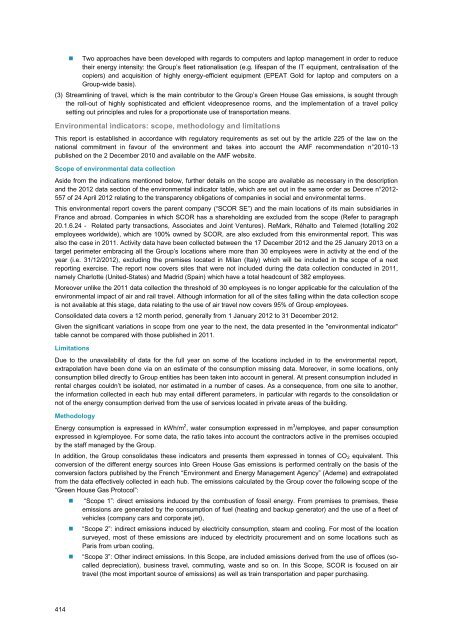4.4 Legal risk - Scor
4.4 Legal risk - Scor
4.4 Legal risk - Scor
Create successful ePaper yourself
Turn your PDF publications into a flip-book with our unique Google optimized e-Paper software.
• Two approaches have been developed with regards to computers and laptop management in order to reduce<br />
their energy intensity: the Group’s fleet rationalisation (e.g. lifespan of the IT equipment, centralisation of the<br />
copiers) and acquisition of highly energy-efficient equipment (EPEAT Gold for laptop and computers on a<br />
Group-wide basis).<br />
(3) Streamlining of travel, which is the main contributor to the Group’s Green House Gas emissions, is sought through<br />
the roll-out of highly sophisticated and efficient videopresence rooms, and the implementation of a travel policy<br />
setting out principles and rules for a proportionate use of transportation means.<br />
Environmental indicators: scope, methodology and limitations<br />
This report is established in accordance with regulatory requirements as set out by the article 225 of the law on the<br />
national commitment in favour of the environment and takes into account the AMF recommendation n°2010-13<br />
published on the 2 December 2010 and available on the AMF website.<br />
Scope of environmental data collection<br />
Aside from the indications mentioned below, further details on the scope are available as necessary in the description<br />
and the 2012 data section of the environmental indicator table, which are set out in the same order as Decree n°2012-<br />
557 of 24 April 2012 relating to the transparency obligations of companies in social and environmental terms.<br />
This environmental report covers the parent company (“SCOR SE”) and the main locations of its main subsidiaries in<br />
France and abroad. Companies in which SCOR has a shareholding are excluded from the scope (Refer to paragraph<br />
20.1.6.24 - Related party transactions, Associates and Joint Ventures). ReMark, Réhalto and Telemed (totalling 202<br />
employees worldwide), which are 100% owned by SCOR, are also excluded from this environmental report. This was<br />
also the case in 2011. Activity data have been collected between the 17 December 2012 and the 25 January 2013 on a<br />
target perimeter embracing all the Group’s locations where more than 30 employees were in activity at the end of the<br />
year (i.e. 31/12/2012), excluding the premises located in Milan (Italy) which will be included in the scope of a next<br />
reporting exercise. The report now covers sites that were not included during the data collection conducted in 2011,<br />
namely Charlotte (United-States) and Madrid (Spain) which have a total headcount of 382 employees.<br />
Moreover unlike the 2011 data collection the threshold of 30 employees is no longer applicable for the calculation of the<br />
environmental impact of air and rail travel. Although information for all of the sites falling within the data collection scope<br />
is not available at this stage, data relating to the use of air travel now covers 95% of Group employees.<br />
Consolidated data covers a 12 month period, generally from 1 January 2012 to 31 December 2012.<br />
Given the significant variations in scope from one year to the next, the data presented in the "environmental indicator"<br />
table cannot be compared with those published in 2011.<br />
Limitations<br />
Due to the unavailability of data for the full year on some of the locations included in to the environmental report,<br />
extrapolation have been done via on an estimate of the consumption missing data. Moreover, in some locations, only<br />
consumption billed directly to Group entities has been taken into account in general. At present consumption included in<br />
rental charges couldn’t be isolated, nor estimated in a number of cases. As a consequence, from one site to another,<br />
the information collected in each hub may entail different parameters, in particular with regards to the consolidation or<br />
not of the energy consumption derived from the use of services located in private areas of the building.<br />
Methodology<br />
Energy consumption is expressed in kWh/m 2 , water consumption expressed in m 3 /employee, and paper consumption<br />
expressed in kg/employee. For some data, the ratio takes into account the contractors active in the premises occupied<br />
by the staff managed by the Group.<br />
In addition, the Group consolidates these indicators and presents them expressed in tonnes of CO 2 equivalent. This<br />
conversion of the different energy sources into Green House Gas emissions is performed centrally on the basis of the<br />
conversion factors published by the French “Environment and Energy Management Agency” (Ademe) and extrapolated<br />
from the data effectively collected in each hub. The emissions calculated by the Group cover the following scope of the<br />
“Green House Gas Protocol”:<br />
• “Scope 1”: direct emissions induced by the combustion of fossil energy. From premises to premises, these<br />
emissions are generated by the consumption of fuel (heating and backup generator) and the use of a fleet of<br />
vehicles (company cars and corporate jet),<br />
• “Scope 2”: indirect emissions induced by electricity consumption, steam and cooling. For most of the location<br />
surveyed, most of these emissions are induced by electricity procurement and on some locations such as<br />
Paris from urban cooling,<br />
• “Scope 3”: Other indirect emissions. In this Scope, are included emissions derived from the use of offices (socalled<br />
depreciation), business travel, commuting, waste and so on. In this Scope, SCOR is focused on air<br />
travel (the most important source of emissions) as well as train transportation and paper purchasing.<br />
414
















